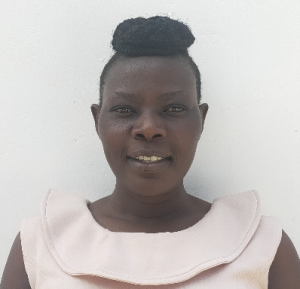April, 2023: Shiralumwa Community Spring Protection Complete!
Shiralumwa Community now has access to clean water! Thanks to your donation, we transformed Chitechi Spring into a flowing source of naturally filtered water. We also installed a chlorine dispenser to provide added protection and trained the community on improved sanitation and hygiene practices. Together, these components will unlock the opportunity for community members to live better, healthier lives.
"Before this water point, we used to drink not very clean water because the source was open to contamination," said 30-year-old Esther, whom we interviewed on our first visit to Shiralumwa. "Most of the time, we used to find ourselves sick, not knowing that the cause of our sickness was drinking unclean water. Now that our water is clean and safe, [we] will be able to live a healthy life. I will be to save money that I used to spend on medication to do other productive projects."

Esther at the newly protected spring.
"I am planning to extend my farming career by venturing into diverse farming," Esther continued. "[I] am planning to plant [a] variety of vegetables and arrowroot. I will be able to direct the wastewater [from the spring] to my farm. I will be able to embrace the modern methods of agriculture. This will make me produce more products than before. I will sell my produce at Shianda Market and be [able] to earn an extra coin to help my husband with our children's school fees."
Children were just as excited as adults about the new waterpoint.
"This water is clean. It is not like before," said Esther's 15-year-old son, Hillary. "This means I will lead a healthy life. I will not be sick because of drinking dirty water. Living a healthy life with no sickness, I will be able [to] spend most of my days in school and not at home. I will be able to manage my time well and spare some little time for playing and mingling with friends."
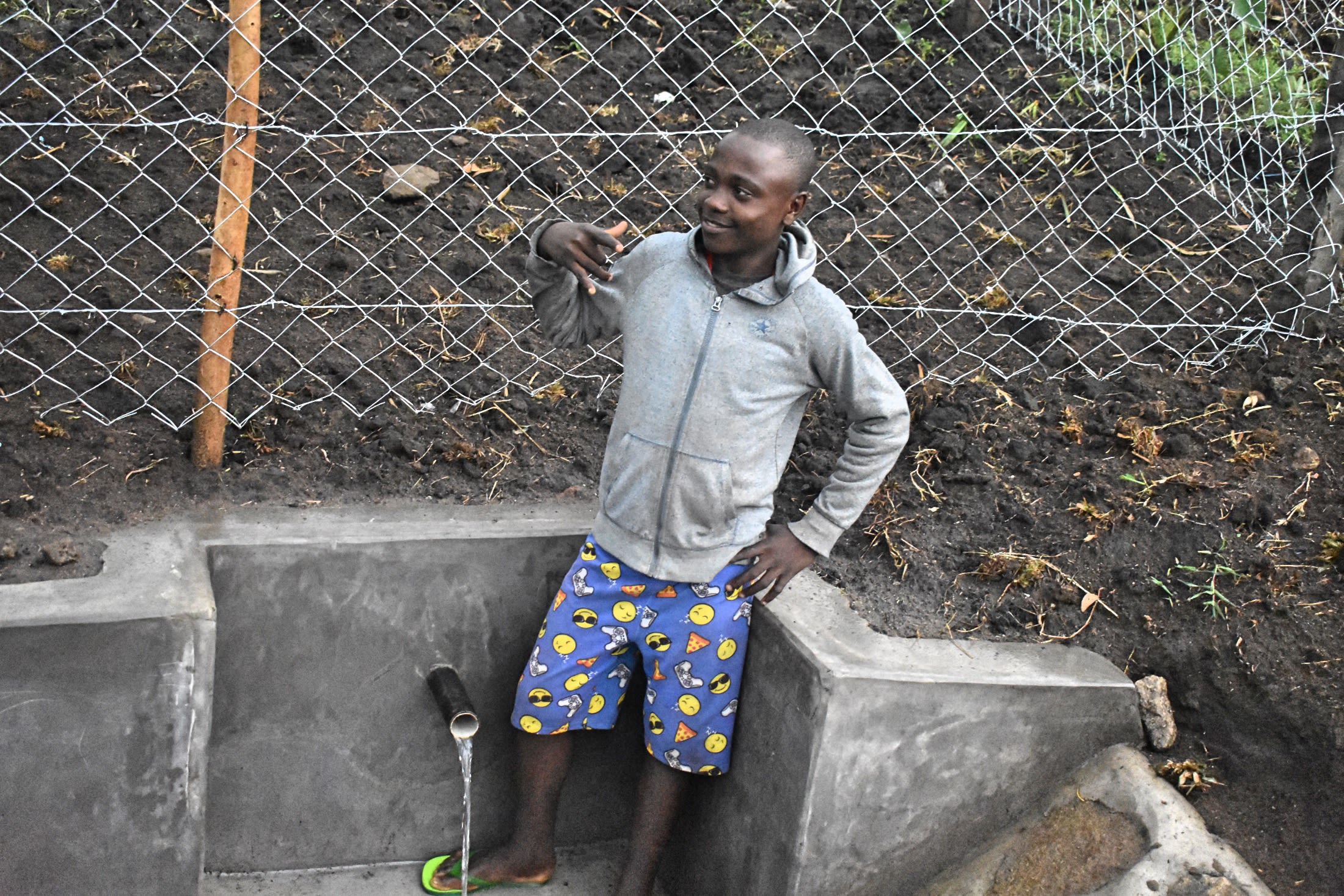
Hillary.
"Before this water point was constructed, we used to waste a lot of time fetching water, especially [during] the rainy seasons," Hillary continued. "During [the] rainy season, the water was dirty, so you had to give it some time to settle and be clean before fetching [it]. You [would] always pray that it doesn't rain so that you can be able to get clean water. Now that this water point has been protected, [I] no longer have worries of rains and dirt. I have the assurance that whenever I want water, I'll just get clean water anytime I want it. This will save me a lot of time, and I will now concentrate on my studies. I will work harder to be able to have a bright future. With the bright future in me, I will be able to help my people out of poverty."
Preparing for Spring Protection
Community members worked together to source and carry all locally available construction materials to the spring. These included bricks, sand, stones, and fencing poles. Some people also chiseled away at large rocks to break them into gravel. Because people have to carry most items by hand, the material-collection process can take anywhere from a few weeks to months.

Stone gathered by community members before construction.
When the community was ready, we sent a truck to deliver the remaining construction materials, including cement, plastic tarps, and hardware. Then, our construction artisan and field officers deployed to the spring to begin work. Individual households provided meals throughout each day to sustain the work team.
From Open Source to Protected Spring: A Step-by-Step Process
First, we cleared and excavated the spring area. Next, we dug a drainage channel below the spring and several runoff diversion channels above and around the spring. These help to divert surface contaminants away.
To ensure community members could still access water throughout the construction process, we also dug temporary channels around the construction site from the spring's eye. This allowed water to flow without disrupting community members' tasks or the construction work. Excavation created space for setting the spring's foundation, made of thick plastic, wire mesh, concrete, and waterproof cement.

Spring's foundation underway.
After establishing the base, we started brickwork to build the headwall, wing walls, and stairs. Once the walls had grown tall enough, we began one of the most crucial steps: setting the discharge pipe. The discharge pipe needs to be positioned low enough in the headwall so the water level never rises above the spring's eye, yet high enough to allow room for the average jerrycan (a 20-liter container) to sit beneath the pipe without making contact, which prevents cross-contamination.
If we place the discharge pipe too high above the spring's eye, back pressure could force water to emerge elsewhere. Too low, and community members would not be able to access the water easily. We embedded the pipe using clay (or mortar when the clay is in short supply) and placed it at an incline to ensure water flows in the right direction.
In coordination with brickwork, we pitched stones on both sides of the spring's drainage channel. We then cemented and plastered each stone, forming the rub walls. These walls discourage people and animals from standing in that area, which could cause soil erosion and a clogged drainage area.

We then cemented and plastered both sides of the headwall and wing walls. These finishing layers reinforce the brickwork and prevent water in the reservoir from seeping through the walls. In turn, enough pressure builds in the reservoir box to push water out through the discharge pipe.
As the headwall and wing walls cured, we cemented and plastered the stairs and installed four tiles beneath the discharge pipe. The tiles protect the concrete from the falling water's erosive force while beautifying the spring and facilitating easy cleaning of the spring floor.
The final stage of construction is backfilling the reservoir box behind the discharge pipe. We cleared the collection box of any debris that may have fallen during construction. Then we redirected the temporary diversion channels back into the reservoir box, channeling water into this area for the first time. We close all other exits to force water through only the discharge pipe.

Backfilling underway.
We filled the reservoir area with the large, clean stones community members had gathered, arranging them in layers like a well-fitting puzzle. We covered the rocks with a thick plastic to minimize potential contamination sources, then piled enough dirt on top to compensate for future settling.
Community members transplanted grass onto the backfilled soil to help prevent erosion. The collection area was fenced to discourage any person or animal from walking on it. Compaction can lead to disturbances in the backfill layers and potentially compromise water quality.
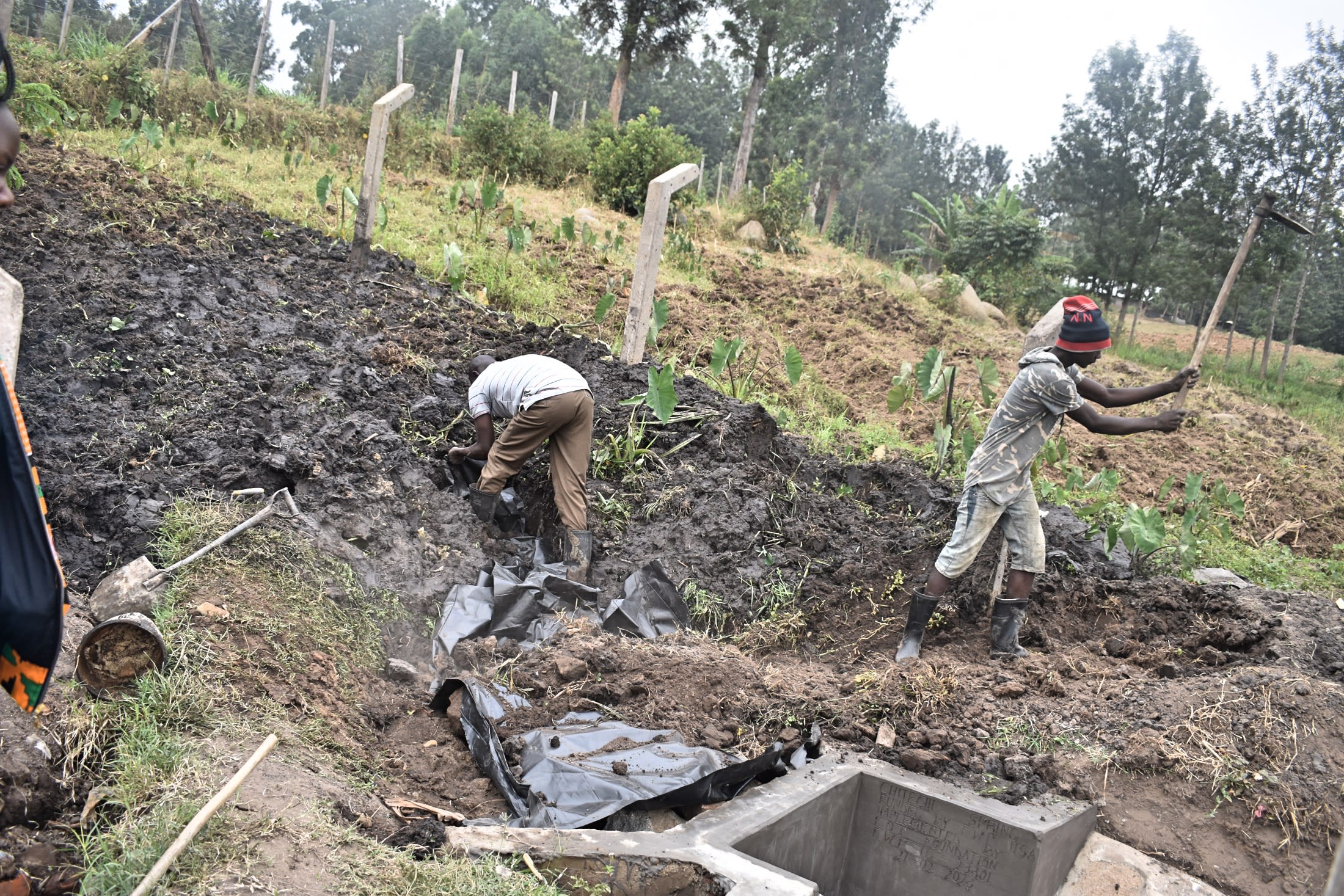
The construction process took about two weeks of work and patience to allow the cement and plaster to finish curing. As soon as the spring was ready, people got the okay from their local field officers to fetch water.
We officially handed over the spring to mark the community's ownership of the water point. Happiness, thanksgiving, and appreciation were the order of the day, flowing in all directions.
"There was dancing and singing at the water point, indicating their sincere joy and appreciation [for] the project," said field officer Adelaide. "The chairperson [of the water user committee], Mr. Juma, sincerely appreciated [everyone who gave] them access to clean water."
Training on Health, Hygiene, and More
Together with the community, we found their preferred date for training while considering other community calendar events, such as the agricultural season and social events. We requested a representative group of community members to attend training and relay the information learned to the rest of their families and friends.
When the day arrived, facilitators Jacqueline, Joyce, Adelaide, and Faith deployed to the site to lead the event. 16 people attended the training, including 14 women and two men. We held the training at a community member's home underneath a shady tree.

We covered several topics, including community participation in the project, leadership and governance, personal and environmental hygiene, water handling and treatment, spring maintenance, dental hygiene, the ten steps of handwashing, disease prevention, and how to make and use handwashing stations.
During the leadership and governance session, we held an election for the newly formed water user committee leaders, who will oversee the maintenance of the spring. We also brainstormed income-generating activities. Community members can now start a group savings account for any future minor repairs to the spring and a cooperative lending group, enabling them to develop small businesses.
At one point, the training facilitator asked the participants who treated their water prior to drinking it, and no one raised their hands. The reasons given for this surprised the facilitators.

"One said that their water is blessed, since it's natural, and it was there before they were born," said facilitator Adelaide. "Their grandparents drank from the same water point, and they were never sick because of water. They also said that they dislike the taste of chlorine in water, and that's why they love their water natural."
Adelaide went on to explain that there are multiple methods of treating drinking water that will help prevent water-related diseases in the future but won't add the taste of chlorine, such as boiling and solar disinfection. She also reminded them of all the money they had spent in recent years treating water-related illnesses and said adding this step to their routine would help prevent these costs in the future. Eventually, the participants agreed to treat their water using whatever method their household finds easiest.
"This training has been of so much value to me," said 12-year-old Asha B. "I have learned that it is important to wash my hands with soap always. If soap is not available or affordable, I can use ash on the job and sand as an alternative to soap, as long as I wash and rinse (with running water) thoroughly. The sand or ash acts as an abrasive and 'rubs off' the dirt and germs. The flowing water takes the dirt and germs away. I can have flowing water by using a tap, a jug, or a tippy tap. Using a basin filled with water to rinse [my] hands will not make my hands clean because the dirt and germs may not flow off the hands. This new knowledge will help me live a healthy life. This means that I will not suffer from hygiene-related diseases such as cholera, typhoid, and diarrhea."
Conclusion
This project required a substantial collaboration between our staff, our in-country teams, and the community members. When an issue arises concerning the spring, the water user committee is equipped with the necessary skills to rectify the problem and ensure the water point works appropriately. However, if the issue is beyond their capabilities, they can contact their local field officers to assist them.
Also, we will continue to offer them unmatchable support as a part of our monitoring and maintenance program. We walk with each community, problem-solving together when they face challenges with functionality, seasonality, or water quality. Together, all these components help us strive for enduring access to reliable, clean, and safe water for this community.
With your contribution, one more piece has been added to a large puzzle of water projects. In our target areas, we’re working toward complete coverage of reliable, maintained water sources within a 30-minute round trip for each community, household, school, and health center. With this in mind, search through our upcoming projects to see which community you can help next!
Thank you for making all of this possible!

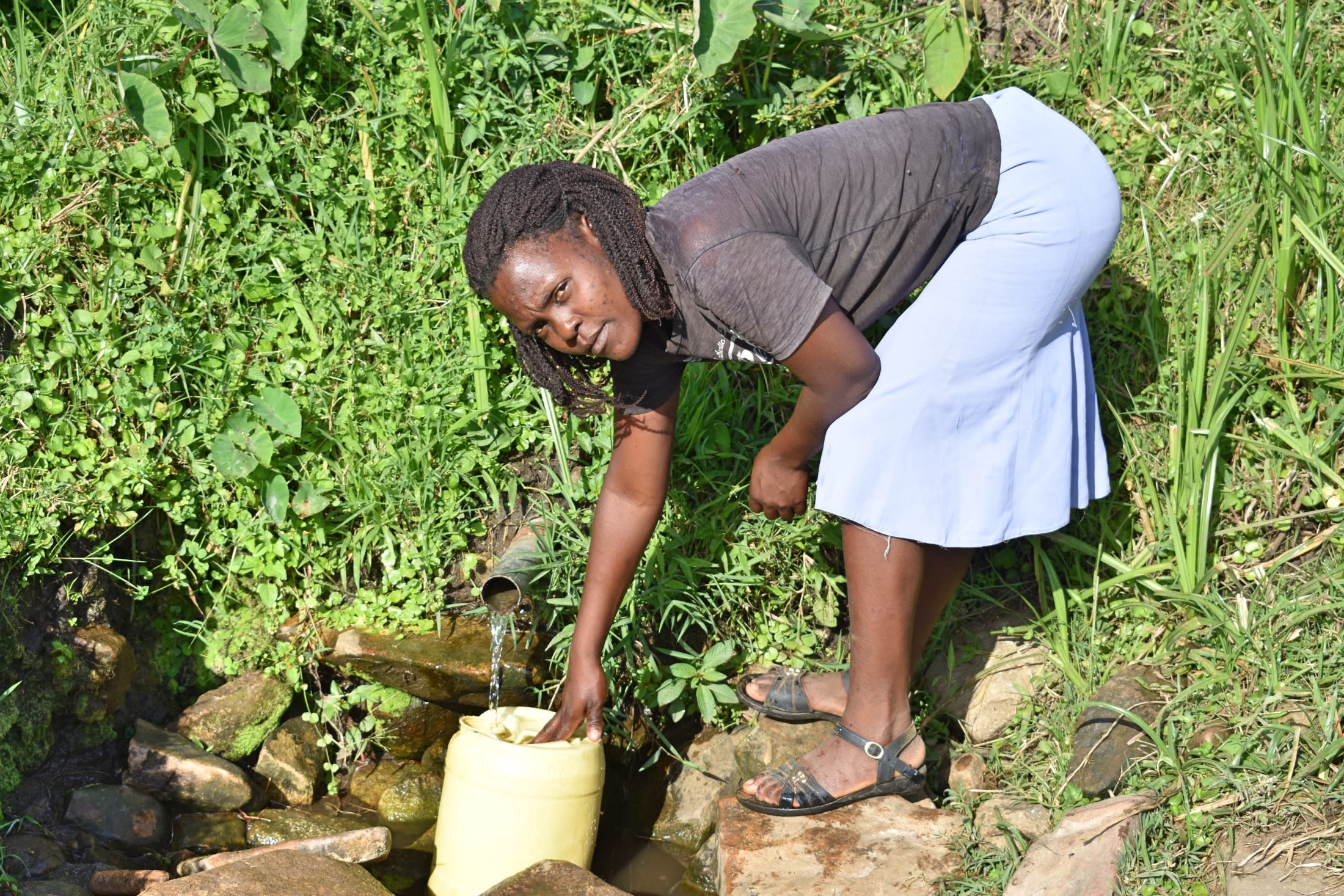
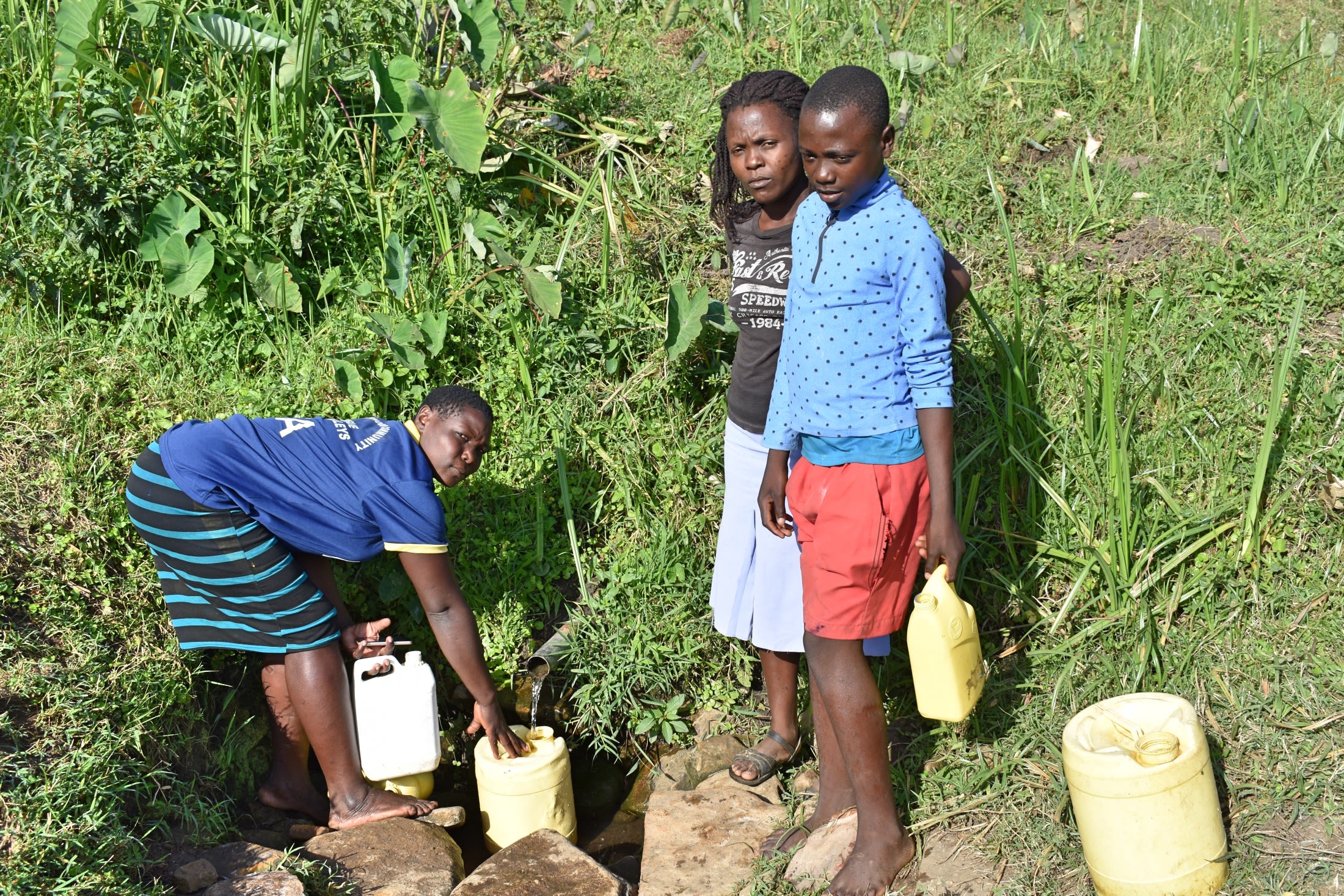

 Protected Spring
Protected Spring
 Rehabilitation Project
Rehabilitation Project










